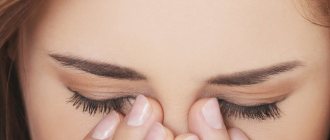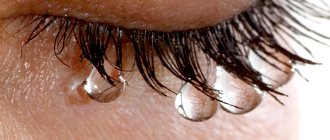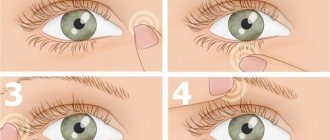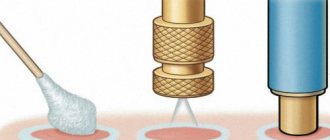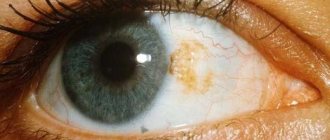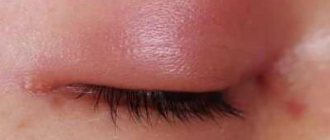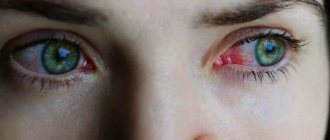Joy and sadness, pain and relief - how many emotions in our everyday life are associated with tears! We start life with them, we meet and see off our dear people with them. Without even thinking about it, we use our tears every day to keep our eyes healthy.
However, sometimes lacrimation can become too strong - and this pathological condition can be explained. A watery eye in an adult: causes, possible diseases and treatment methods - in our article.
Tear fluid
- a special secret produced by paired lacrimal glands located in the lacrimal fossa: a special depression in the frontal bone, on the outer side of the eye sockets. The fluid flows through the excretory canaliculi from the glands into the conjunctival sac and accumulates under the lower eyelid. The function of the upper eyelid is its distribution over the surface of the eyeball.
The lacrimal fluid that has fulfilled its purpose is discharged through special drainage tracts - lacrimal stream, lake and canaliculi - into the lower nasal passage, where it continues to provide benefits by moisturizing the mucous surface. Its remains evaporate there.
Causes of teary eyes
Increased tearing of the eyes can occur in both the elderly and children, and there are two types:
- Hypersecretory. Increased function of the lacrimal glands to produce tear fluid.
- Terence. Disturbances in the functioning of the lacrimal ducts.
Causes of teary eyes can be:
- Conjunctivitis. Conjunctivitis can be bacterial, viral, or even allergic. It is impossible to make such a diagnosis on your own; only an ophthalmologist can help with this.
- Stress and nervous disorders. If eye drops prescribed by the treating ophthalmologist do not help with increased tearing of the eyes, then it may be caused by nervous disorders and you should consult a neurologist.
- Allergy. Allergies can be seasonal or to cosmetics. If you are allergic to cosmetics, it is recommended to stop using them. Seasonal allergies usually appear in the spring and summer, and can be due to bright sun, pollen from trees, flowers and shrubs, citrus fruits, animal dander, dust and even perfume odors. In winter, the cause of allergies can be strong wind and frost, and in the cold the eyes begin to water; in the fall, it manifests itself in unfavorable weather conditions and vitamin deficiency.
- Incorrectly selected contact lenses and glasses. Glasses and contact lenses can only be selected by an ophthalmologist using special medical equipment. In addition, they must be properly cared for and the lenses must be washed only with high-quality liquids.
- Injuries, burns of the cornea. In case of eye injury or foreign objects, in order not to harm yourself, you must consult an ophthalmologist. A burn to the cornea of the eye can be caused by exposure to ultraviolet radiation, when working with a welding machine or in a solarium.
- Tick parasite or fungus. The cause of regular, incessant itching and discomfort in the eye area may be a mite or fungus. You won’t be able to determine this on your own, only in a medical institution as a result of an examination.
- Age. In people over 50 years of age, the eye muscles weaken, the structure and functioning of the tear ducts change. This disorder is called dry eye syndrome. Only the attending physician can prescribe treatment.
- Colds. Some colds and viral diseases can cause increased tearing and redness of the eyes.
- Tired eyes. After working at the computer for a long time, in the shade or watching movies, my eyes can get tired, and it is recommended to take a break for vision.
- Lack of vitamins and microelements . Vitamin deficiency reduces the body's protective functions, resulting in an increased risk of developing various diseases. Often, a lack of potassium can lead to increased tearing of the eyes.
- Impaired outflow of tear fluid. Increased tearing of the eyes can occur with narrowing or complete obstruction of the lacrimal ducts. In this case, it can only be corrected surgically.
Left untreated, it can impair vision or lead to blocked or narrowed tear ducts.
Watery eyes in the morning: general symptoms
Note! If your eyes water in the morning, this is considered normal in the absence of the following additional symptoms:
- itching, burning and irritation;
- severe persistent redness of the conjunctiva;
- painful sensations.
This tearing is explained by the fact that at night the glands responsible for the production of tear fluid work poorly and the mucous membranes of the eyes lose a large amount of moisture during the night.
In the morning, when the glands are activated, there is an accelerated restoration of the balance of tear fluid on the surface of the eyeball , and its small excesses are released out in the form of tears.
Additionally, yawning stimulates morning tear production - during this process, the infraorbital muscles tense and change position, which compress the lacrimal sacs and tears are released.
Obviously, short-term morning tearing is normal and does not require intervention.
But if such a disorder does not go away for a long time and causes discomfort or pain, it may be due to pathological conditions.
But they already require accurate diagnosis and proper treatment.
Symptoms of teary eyes
In addition to increased tearing, there are also similar symptoms:
- Painful sensations.
- Purulent discharge.
- Discomfort in the form of burning and stinging.
- Photophobia.
- Redness of the eyes.
If these symptoms appear, you should see an ophthalmologist; if there are no other symptoms besides tearing, then you can eliminate this yourself at home.
Diagnostic measures
It is impossible to determine the causes of lacrimation after sleep on your own; professional medical assistance is required. If the symptom persists and bothers you, contact your ophthalmologist. Sometimes the problem is visible upon examination, but additional diagnostic procedures may be required: tests with fluorescent dyes, dacryocystography. To identify neoplasms (polyps) or foreign objects, radiography, magnetic resonance or computed tomography, and ultrasound are used. To detect infectious agents, tests of secreted mucus or blood are indicated.
If the ophthalmologist has not identified any pathologies, go to your local physician. A general blood test will help identify inflammation and systemic infections occurring in the body, and a lack of certain substances.
Drug treatment for watery eyes
The treatment of eye diseases must be taken seriously, since wasting time can worsen vision.
Only an ophthalmologist can make an accurate diagnosis and accordingly prescribe the necessary medications that can help with tearing eyes based on a medical examination, and only he can correctly select the necessary eye drops (antibacterial, anti-inflammatory or moisturizing). In most cases, eye drops can help with tearing.
If watery eyes are associated with a burn to the cornea caused by working with a welding machine without a protective mask, then the doctor usually prescribes antiseptic liquids for washing the eyes and drops with anesthetics. You will also be advised to wear sunglasses in sunny weather.
If a diagnosis of dry eye syndrome is made, it is necessary to restore the level of moisture in the conjunctiva.
Depending on the cause of increased tearing, all eye drops are divided into several groups:
- Antibacterial drops (Okomistin). These drops contain a broad-spectrum antibiotic. Such drops help relieve inflammatory processes, even help with damage to the lacrimal glands. Typically, such drops are prescribed in combination with other drugs.
- Antiallergic drops (Acular, Patanol, Azelastine, Olopatadine, Ketotifen, Lecrolin, Lotoprednol, Opantol, Octilia, Visin, Okumetil). Such drops help get rid of allergic reactions in the form of redness, swelling, itching and burning, blocking the immune response to the influence of the allergen. If you are allergic to cold, you should reduce your time outdoors. Your diet should include foods rich in vitamins A, B, C and potassium.
- Corticosteroid drops (Lotoprednol). Drops of this type contain corticosteroid hormones, which are indicated for severe allergic reactions and serious inflammation. The drops are great for helping with discomfort: swelling, inflammation and watery eyes.
- Decongestant and vasoconstrictor drops (Visin, artificial tears, Opkon-A, Nafkon-A). With constant eye strain (while driving, working with papers or working on a computer). Such drops constrict blood vessels, resulting in swelling and redness. In their composition, such drugs resemble tear fluid. Also, in addition to drops, you need to give your eyes a rest and create the right lighting in the workplace.
Treatment options
Keep in mind! Morning lacrimation does not require specific targeted treatment if it is short-term and not accompanied by painful sensations and visual pathological symptoms.
In most situations , when noticeable redness of the conjunctiva, pain in the eyes and eyelids, as well as the release of purulent accumulations and sticking of the eyes due to this, are observed during lacrimation, it is necessary to carry out therapy with the use of antibacterial drugs.
After examination by an ophthalmologist, the following of these medications in the form of drops may be prescribed
- levofloxacin;
- tobrex;
- ciprofloxacin;
- azithromycin;
- Albucid.
, ophthalmic ointments (erythromycin, hydrocortisone, tetracycline) will be more effective
Such drugs not only suppress the activity of pathogenic bacteria, but also help eliminate inflammatory processes, quickly preventing lacrimation.
If the cause of such a symptom is fatigue of the visual organs , instillation of moisturizing drugs (Slezin, Visine, Systane) may be required.
But such a symptomatic and protective effect of these drugs manifests itself over time if such drops are used daily as needed.
Know! Often in the spring, tears in the morning are a sign of allergic reactions caused by contact with plant pollen (although allergies can occur to various foods and medications).
In such situations, it is first of all important to first limit contact with the allergen , after which, in accordance with the instructions for use, you should take a course of antihistamines : kromofarm, opatanol, azelastine, lecroline, olopatadine and others.
Possible complications of watery eyes
In addition to the fact that increased tearing of the eyes causes discomfort, it can also damage the skin, causing redness and crusts to form. If you do not follow the rules of personal hygiene, if you wipe your tears with a non-sterile scarf or napkin, you can cause an infection.
If increased tearing occurs when wearing contact lenses, then it is recommended to abandon them and use glasses. If these recommendations are not followed and unpleasant symptoms are ignored, vision may deteriorate.
Preventing teary eyes
To prevent tearing and pain, you can use a 4% solution of taufon, which can normalize metabolic processes in the eye area.
As a preventive measure to prevent tearing of the eyes, it is necessary to:
- Timely treatment of colds. Often, increased lacrimation occurs during a cold, as swelling of the nasal mucosa occurs and the nasal passages narrow, which reduces the function of lacrimal drainage. To avoid this, you need to try not to catch a cold.
- Protect your eyes from sudden changes in temperature and from foreign bodies.
- Include more fruits and vegetables in your diet . It is recommended to drink more herbal and green teas and eat vegetables containing vitamin A, as they can help improve vision.
- Regular examination by an ophthalmologist. It is important to monitor the condition of your eyes, when the first discomfort and symptoms appear, contact an ophthalmologist; this can avoid possible complications and preserve your vision in the future.
- Use lenses correctly. It is necessary to properly care for them and monitor their hygiene. During the day, you need to go without lenses to give your eyes a rest. It is necessary that the lenses are constantly clean, because even an ordinary speck of dust that ends up between the eye and the lens can lead to serious consequences.
- Try to prevent infection. It is recommended not to touch your eyes with dirty hands, this will help prevent infection. Try not to rub your eyes. In public pools and reservoirs, use special protective goggles for swimming, this will help avoid infection in the eyes, in particular conjunctivitis.
- Use cosmetics correctly. Do not use someone else's mascara and be sure to wash off your makeup before going to bed. Use cosmetics that have not expired.
Diagnostics
The patient is examined in several stages:
- Collection of complaints from the patient. He may experience headaches, discomfort in the eyes, and a burning sensation.
- General inspection. In addition to increased lacrimation, the patient may experience redness of the eyes, an inflammatory condition of the eyelids, conjunctiva, cornea, and lacrimal sac. The doctor may use a slit lamp for a more detailed examination. With its help, you can identify folk particles on the mucous membrane.
- Measuring visual acuity using diagnostic tables. The more lines the patient sees, the better the quality of his vision.
- Fundus examination. A drug that disrupts the accommodation of the pupil is first instilled. The doctor can assess the condition of all intraocular elements.
- Measuring intraocular pressure to detect or rule out glaucoma.
- Bacterial culture to determine infection.
- PCR method for detecting the virus.
Having identified the exact cause of the condition, the doctor can begin treatment.
Treatment of teary eyes with folk remedies
Traditional medicine is rich in different ways and recipes for teary eyes. To avoid harm to your vision, you need to consult an ophthalmologist.
- Lavender . 1 teaspoon of lavender leaves and flowers is steamed in a glass of boiling water and infused for half an hour. After cooling, the infusion is filtered. Cotton pads soaked in this infusion are applied to the eyes for 20 minutes twice a day, morning and evening. The course of treatment is 15 days.
- Caraway. Pour 1 teaspoon of cumin seeds into a glass of boiling water, bring to a boil and simmer over low heat for 3 minutes. Add 1 teaspoon of plantain leaves and cornflower petals to the decoction and put it in a dark place for a day. Then you should strain and instill 2 drops into each eye 5 times a day.
- Cornflower. 1 teaspoon of cornflower is poured into a glass of boiling water, covered and infused for an hour. After the infusion has cooled, apply cotton pads soaked in it and apply to the eyes for 20 minutes. The course of treatment is at least 15 days.
- Coconut oil . Lubricate the area around the eyes with oil. A positive effect usually begins to appear after several procedures. The result is a moisturizing and soothing effect on the area around the eyes.
- Millet. 2 teaspoons of millet are poured into 1 liter of boiling water; after boiling, cook over low heat for 5-6 minutes. The first results will already appear after the first applications. Use to wash eyes before bed.
- Aloe. Pour 1 teaspoon of finely chopped aloe leaves into a glass of water and leave overnight. In the morning, the infusion is ready and you can use it to wash your sore eyes. Helps even with excessive tearing of the eyes.
- Soda and ascorbic acid. Mix 1 teaspoon each of baking soda and ascorbic acid crystals and dissolve in a glass of warm water. Then soak cotton pads in this solution and apply to eyes for 20 minutes.
- Black tea. 2 brewed black tea bags are applied to inflamed areas. Also apply cotton pads soaked in strong black tea to your eyes for 15 minutes. This recipe allows you to restore the patency of the lacrimal ducts and relieve inflammation.
- Chamomile. Steam 1 tablespoon of chamomile leaves in a glass of boiling water, after cooling, strain and use it as an eye lotion using cotton pads.
- Rose hip. Steam 1 tablespoon of rose hips in a glass of boiling water, after cooling, strain and apply cotton pads soaked in the infusion to the eyes.
- Potato. Wrap the grated potatoes in gauze and apply for 40-45 minutes, then wash with cool water. This procedure is done a few hours before bedtime, it perfectly relieves inflammation.
- Apple cider vinegar and honey. For 1 glass of water, take 1 teaspoon of apple cider vinegar and 1 teaspoon of honey, mix everything thoroughly and take it as a drink. It is recommended to drink 1 glass daily.
- Dill. 1 tablespoon of dill seeds is poured into 2 glasses of cold water. Bring to a boil, wrap and let brew for 2-3 hours. Before going to bed, wash your face and apply cotton pads to your eyes for 10 minutes. Course 14 days.
- Propolis. Pour a little propolis with warm water in a ratio of 1:20. Strain the resulting infusion and instill 3 drops into each eye. You may feel itchy, but don't worry, there won't be any harm. Excellent for bacterial infections.
Attention! Store all resulting decoctions and infusions only in the refrigerator for 48 hours!


